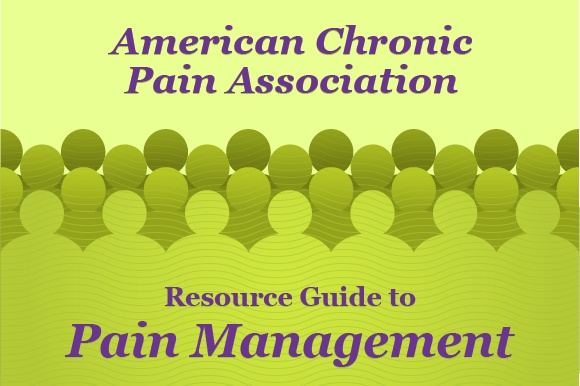American Chronic Pain Association: Resource Guide to Pain Management

It is difficult to know how to move forward once chronic pain has altered someone’s life. It often seems like all that is needed is the right medication or treatment to take away the pain to improve their function. But sometimes that is not enough - especially in the instance of chronic pain. Medication, injections, or surgery sometimes only provide minimal relief. However, there are many other treatment approaches to chronic pain to provide better results.
What is Chronic Pain?
Chronic pain is any pain that lasts for more than three months. The pain can become progressively worse and reoccur intermittently, outlasting the usual healing process and adversely affecting the individual’s well-being. After injured tissue heals, pain is expected to stop once the underlying cause is treated. However, chronic pain can persist after injuries heal for no apparent biological cause.
The most common sources of chronic pain include low back pain, headache and arthritic pain. Chronic pain can cause significant psychological and emotional trauma and often limits an individual’s ability to fully function.
American Chronic Pain Association
For nearly 40 years, the American Chronic Pain Association (ACPA) has been helping people live fuller lives despite their pain. Their goal is to provide people with the resources they need, in addition to what their health care providers offer, so that they can improve their skills in the self-management of chronic pain.
The ACPA’s definition of “successful” treatment of a person with chronic pain is that the person has learned how to independently self-manage their condition in a way that allows life to continue by maximizing participation in everyday life activities, minimizing discomfort and side effects, and avoiding other negative consequences of treatment. This does not mean that the person will be pain free, but rather be able to manage pain and lead a productive, satisfying, and happy life.
The ACPA Resource Guide to Chronic Pain Management
The Resource Guide to Chronic Pain Management combines practical clinical experience and the most recent scientific information presented in an easy to read format for consumers and professionals. Pain relief may be better obtained when medications and therapies are accompanied by or even replaced by other active rehabilitation, educational approaches, and behavioral-psychological treatments.
Living a full life with pain requires that the person take an active role in the recovery process.
Beyond medications, the guide discusses a variety of therapy options, such as acupuncture, manipulation and mobilization, electrical stimulation devices, and trigger point injections. Active interventions including education, exercise, tai chi, yoga, graded motor imagery, psychological and behavioral approaches, and mind-body interventions are also described.
Here are a few examples of alternative treatments in the guide and the effect they have on chronic pain:
- EXCERCISE
Patients with chronic pain benefit tremendously by staying as physically active as possible. Active therapy is based on the philosophy that therapeutic exercise and/or activity are beneficial for restoring flexibility, strength, endurance, function, and range of motion, and can decrease discomfort. The Resource Guide provides specific details of how different types of exercise may benefit a person experiencing chronic pain. For example, yoga creates a greater sense of health and well-being by emphasizing mindful practice, breath awareness, and proper body alignment. Yoga helps to manage chronic pain through movements that increase flexibility, strength, and relaxation.
- ART & MUSIC
Art and music are creative forms of expression and have been used for some time in psychotherapy to help people express their thoughts and feelings. Art and music stimulate the healing process by helping to decrease stress and release neurotransmitters that can decrease the experience of pain. Many people, when engaged in the creative arts, report that they are less aware of their pain.
- COGNITIVE BEHAVIORAL THERAPY (CBT)
Cognitive behavioral therapy helps provide pain relief by changing the way people view their pain. CBT can change the thoughts, emotions, and behaviors related to pain, improve coping strategies, and put the discomfort in a better context. People recognize that the pain interferes less with their quality of life, and therefore better function is a result.
The Resource Guide also offers information about how medications work in the body, the types of medications used to manage pain and therapies to avoid, and it emphasizes the importance of using medications safely. People with chronic pain benefit from being well informed about their treatments and especially about their prescribed medications. This knowledge may relieve the fears that can interfere with receiving maximum benefits from carefully and appropriately selected treatments and medications. Education can also prevent unrealistic expectations that lead to disappointment with no benefit or even a bad outcome from treatment.
Chronic pain can impact every aspect of a person’s life, not just their physical functioning. The longer the pain condition lasts, the more emotional and mental distress a person tends to feel. This distress can make pain worse over time and lead to decreased functioning. The ACPA’s Resource Guide to Pain Management provides a useful tool to help educate people suffering from chronic pain. It helps them understand about their treatment options and interventions that lead to less stress, more positive behaviors, and a focus on functioning rather than cure.
Other Posts You Might Be Interested In
Subscribe to email updates
Stay up-to-date on what's happening at this blog and get additional content about the benefits of subscribing.


